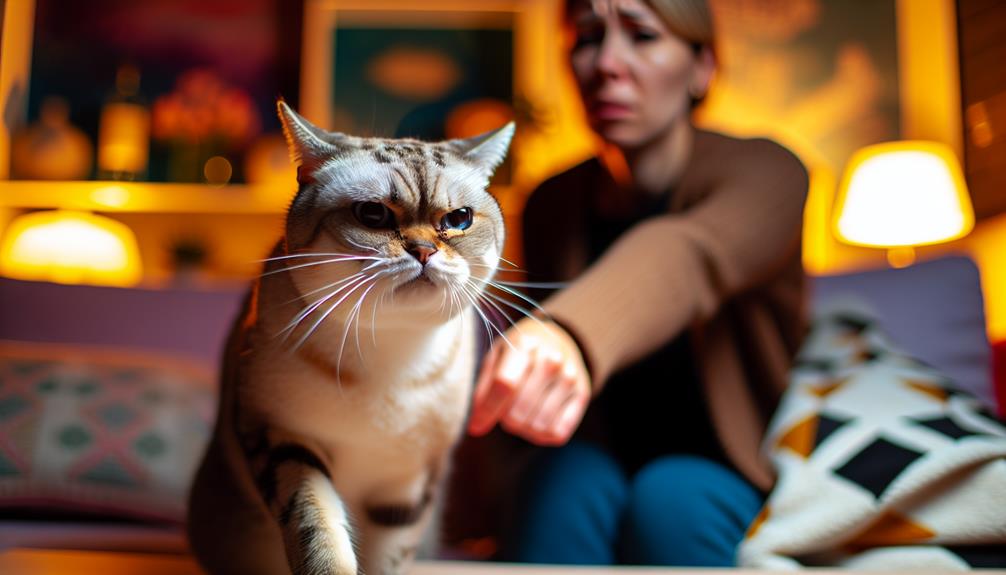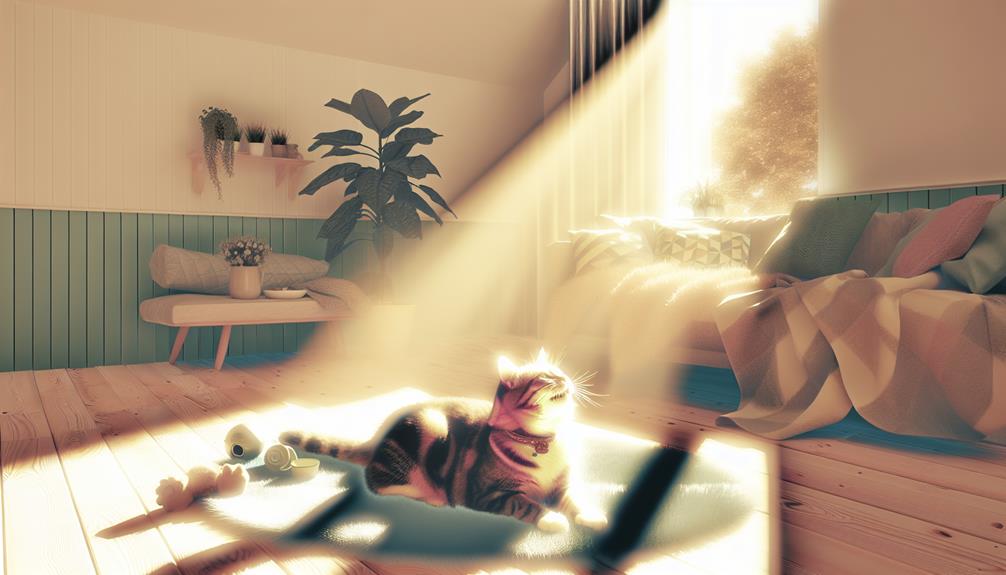You might not realize that cats, unlike dogs, have a complex emotional memory that can affect how long they hold a grudge. It's not just a matter of minutes or hours; sometimes, these feelings can linger for days or even weeks. Have you ever wondered what specific events or disruptions can trigger such prolonged animosity in your feline friend? By understanding these triggers and recognizing the subtle signs of their displeasure, you can work towards mending the relationship. So, how can you tell if your cat is still nursing a grudge and what steps can you take to make amends?
Understanding Cat Emotions
When it comes to understanding cat emotions, it's crucial to recognize that feline emotional expressions can be subtle and complex. Cats have evolved to be both predators and prey, meaning their survival often depends on masking their feelings. As a result, interpreting their emotions requires careful observation of their cat body language and other forms of feline communication.
First, consider a cat's tail. A high, slowly swaying tail generally indicates a relaxed and content cat. Conversely, a puffed-up, bristled tail can signal fear or aggression. Ears also play a significant role; forward-facing ears suggest curiosity or interest, while flattened ears indicate anger or anxiety. These subtle cues are integral to understanding your cat's emotional state.
Additionally, pay attention to their eyes. Slow blinking is often a sign of trust and affection. If a cat maintains prolonged eye contact, especially with constricted pupils, it might feel threatened or defensive. Dilated pupils, on the other hand, can indicate excitement or fear, depending on the context.
Vocalizations are another key aspect of feline communication. A purring cat is typically content, though cats may also purr when anxious or in pain. Hissing, growling, or yowling are more overt signals of distress or displeasure. The frequency and tone of these sounds can provide further insight into their emotional well-being.
Recognizing these signs helps you build a deeper understanding of your cat's emotions, fostering a more empathetic and responsive relationship. By attuning yourself to their body language and vocal cues, you can better address their needs and promote a harmonious coexistence.
Common Reasons for Grudges
You might notice your cat holding a grudge due to a disrupted daily routine, negative past experiences, or territorial invasions. Cats are creatures of habit, and any changes can unsettle them deeply. Understanding these common triggers helps you manage their environment and interactions better.
Disrupted Daily Routine
Routine disruptions can considerably impact a cat's behavior, often leading to what seems like a grudge. Cats are creatures of habit, and any routine changes can act as significant stress triggers. Environmental shifts, such as moving to a new home or even rearranging furniture, can disturb their comfort zones. This leads to behavioral adjustments that may be perceived as a grudge.
When their daily patterns are altered, cats might exhibit changes in activity levels and social interactions. For instance, if you suddenly start working longer hours, your cat could feel neglected and become less affectionate or more aloof. Such disruptions can manifest in various ways, including litter box avoidance, excessive grooming, or even aggression.
Consider the emotional impact of these disruptions:
- Routine Changes: Imagine your cat waiting by the door for you, only for you not to come home at the usual time.
- Environmental Shifts: Think about how unsettling it is for them when everything they know is moved around or changed.
- Daily Patterns: Picture the confusion they experience when their feeding schedule is abruptly altered.
Understanding these factors can help you empathize with your cat and make necessary adjustments to minimize stress.
Negative Past Experiences
Negative past experiences can greatly contribute to a cat's perceived grudge-holding behavior. When a cat undergoes negative reinforcement or past trauma, it can greatly impact their emotional attachment and behavioral responses. For instance, if a cat experiences harsh punishment or neglect, it may develop trust issues, making it wary of human interaction. This lack of trust can elevate anxiety levels and provoke a fear response in situations that remind the cat of its past trauma.
Memory retention in cats plays a significant role in how they react to stress triggers. Cats have a remarkable ability to remember specific events, which means they can associate certain stimuli with negative experiences. As a result, their behavioral responses can be influenced by these past memories, reinforcing the perception of holding grudges.
Social hierarchy also affects a cat's behavior. If a cat has been bullied or mistreated by other animals, it might exhibit defensive behavior towards both animals and humans. Understanding these factors is essential for addressing trust issues and improving the cat's emotional well-being. By recognizing and mitigating the effects of past trauma, you can help your cat develop healthier, more positive interactions.
Territorial Invasions
Just as past traumas can shape a cat's behavior, territorial invasions are another common trigger for perceived grudges. Cats are inherently territorial creatures, and disruptions to their established boundaries can lead to significant stress and behavioral changes. When another animal intrudes into your cat's space, it can disrupt the delicate feline hierarchy, causing your cat to feel threatened and insecure.
Territorial behavior is a fundamental aspect of a cat's natural instincts. When their territory is invaded, it's not just an inconvenience; it's a direct challenge to their sense of security and dominance. This can lead to a grudge that manifests in various ways, such as aggression, hiding, or even avoiding certain areas of your home.
Here are three signs that a territorial invasion might be causing your cat to hold a grudge:
- Increased aggression: Your cat may lash out more frequently, both at the intruder and others.
- Avoidance behaviors: They might start avoiding areas where the invasion occurred.
- Changes in routine: Your cat could exhibit changes in eating, sleeping, or grooming habits.
Understanding these reactions can help you address the root cause and restore harmony in your home.
Signs Your Cat Is Upset

Observing your cat's behavior can provide clear indicators that it's feeling upset. Cats communicate their emotions through various forms of body language and vocalizations, and recognizing these signs can help you understand their emotional state.
Firstly, pay attention to your cat's body language. An upset cat often displays a tense posture, with its fur standing on end, especially along the spine and tail. Their ears might be flattened against their head, and their pupils can appear dilated. Additionally, a swishing or thrashing tail is a common indicator of agitation or discomfort.
Feline vocalizations also offer clues. A cat that's upset might emit low growls, hisses, or yowls. These sounds are generally more intense and prolonged compared to the usual meows. Understanding the nuances of these vocal cues can help you gauge the severity of your cat's distress.
Below is a table summarizing key signs to watch for:
| Behavior | Description | Indicator |
|---|---|---|
| Tense Posture | Stiff body, fur standing on end | Agitation, Fear |
| Flattened Ears | Ears pinned back against the head | Anxiety, Discomfort |
| Dilated Pupils | Wide, black pupils | Stress, Fear |
| Tail Movements | Swishing or thrashing tail | Irritation, Anger |
| Vocalizations | Low growls, hisses, yowls | Distress, Aggression |
Understanding these signs allows you to respond appropriately, providing comfort or space as needed. By empathizing with your cat's expressions, you can foster a stronger bond and guarantee their well-being. Recognizing when your cat is upset is vital in maintaining a harmonious relationship.
Duration of Feline Grudges
Recognizing signs of distress in your cat is the first step in addressing their emotional needs, but understanding how long they hold a grudge is equally important. Cats are known for their complex emotional intelligence and remarkable feline memory, which play significant roles in how they perceive and react to negative experiences. While it might seem like your cat is holding a grudge, it's more about their heightened sensitivity and the way they process emotions.
Studies indicate that a cat's memory can last up to 16 hours, but emotional memories can linger longer. Unlike humans, cats don't hold grudges in the traditional sense. Their reactions are often immediate responses to perceived threats or discomfort. However, if an event causes significant distress, your cat might exhibit avoidance behaviors for several days or even weeks.
Here's what you might observe:
- Avoidance: Your cat may steer clear of you or the area where the negative experience occurred.
- Changes in Behavior: An upset cat might display altered eating habits, increased aggression, or excessive grooming.
- Persistent Fear: Some cats develop long-term fear responses, which can be mistaken for holding a grudge.
Understanding your cat's emotional intelligence and memory helps you empathize with their reactions. Unlike humans, cats live more in the moment, but certain experiences can leave lasting impressions. Their so-called "grudges" are survival mechanisms, ensuring they avoid situations that previously caused them distress. By recognizing these behaviors, you can better support your cat through their emotional recovery, fostering a stronger, more trusting relationship.
Tips to Reconcile With Your Cat

Rebuilding trust with your cat starts with offering tasty treats as a peace offering. Show gentle affection to remind them of your bond, but always respect their space to avoid causing further stress. Understanding these steps can help mend your relationship and reduce the duration of feline grudges.
Apologize With Tasty Treats
When attempting to mend fences with your feline friend, offering tasty treats can be an effective strategy. Cats, like humans, can be motivated by food, and a well-timed treat can help smooth over any misunderstandings. However, treat selection and timing matter greatly when you're trying to reconcile.
First, select high-value treats that your cat truly loves. These aren't just any ordinary snacks; they should be something special that excites your cat. Think of items like freeze-dried chicken or high-quality fish treats. This shows your cat that you're making an extra effort.
Second, timing matters when offering these treats. Don't just toss them at random. Instead, wait for a moment when your cat appears calm and approachable. This will make the gesture more meaningful and effective.
Third, be consistent. One treat won't erase a grudge, but repeated, positive interactions can. Create a routine where your cat expects these special moments, reinforcing that you are a source of happiness and comfort.
- High-value treats: Choose something special.
- Timing: Offer treats when your cat is calm.
- Consistency: Make treat-giving a positive routine.
Offer Gentle Affection
Cats often need time and space to recover from perceived slights, but gently offering affection can be pivotal in mending your relationship. When your cat seems ready, approach them calmly and slowly. Use a soothing voice to reassure them, as the tone of your voice can markedly influence their comfort level.
Start with gentle petting, focusing on areas they typically enjoy, such as under the chin or behind the ears. This approach taps into their positive associations with touch, fostering a sense of security. Be observant of their body language; if they seem receptive, continue with the gentle petting. If they pull away or show signs of discomfort, pause and try again later.
Your presence and calm demeanor are essential. Maintain a relaxed posture to avoid appearing threatening. Speaking in a soothing voice while petting can help lower their stress levels, making them more likely to accept your affection. It's important to be patient and consistent. Over time, your gentle, affectionate efforts can help rebuild trust and strengthen your bond, demonstrating that you're a source of comfort and love. This methodical approach is key to overcoming any grudge they may harbor.
Respect Their Space
Respecting your cat's space is essential for reconciliation, as it acknowledges their independent nature and need for personal boundaries. Cats are naturally territorial and value their safe zones and quiet areas. By giving them the space they crave, you show respect for their instincts and comfort levels.
Here are three tips to help you respect your cat's space:
- Create Safe Zones: Designate specific areas in your home where your cat can retreat undisturbed. These zones should be equipped with their favorite toys, bedding, and hiding spots. This provides a sanctuary for them to feel secure and relax.
- Avoid Intruding on Quiet Areas: Cats often seek out quiet, secluded areas when they need to de-stress. Avoid disturbing these spots, especially if your cat is already feeling anxious or upset. This respect for their need for solitude can greatly aid in rebuilding trust.
- Observe and Adapt: Pay close attention to your cat's body language and behavior. If they show signs of wanting to be alone, such as retreating to a corner or a safe zone, give them the space they need. Adapting to their cues can make a considerable difference in the reconciliation process.
Preventing Future Grudges
To prevent future grudges in cats, it's essential to understand their behavioral cues and respond appropriately. By employing grudge prevention techniques, you can foster a more harmonious relationship with your feline companion. Start with positive reinforcement; reward your cat with treats or affection when they exhibit desirable behavior. Playtime bonding is another effective method, as it strengthens your connection and reduces stress.
Maintaining consistent routines can help your cat feel secure and less anxious. Stress reduction through environmental enrichment is also vital. Provide stimulating toys, scratching posts, and safe spaces where your cat can retreat. Understanding triggers is important; observe what causes your cat to react negatively and try to minimize these situations.
Socialization techniques can be beneficial, especially for younger cats, to help them become more adaptable and less likely to hold grudges. Offering emotional support through gentle petting and calming words can reassure your cat and build trust. Behavioral training can address specific issues and prevent future conflicts, ensuring a more peaceful coexistence.
Here's a table summarizing these strategies:
| Strategy | Description | Benefits |
|---|---|---|
| Positive Reinforcement | Rewarding good behavior with treats or affection | Encourages desirable behavior |
| Playtime Bonding | Engaging in interactive play with your cat | Strengthens bond, reduces stress |
| Consistent Routines | Keeping feeding and playtimes regular | Provides security and reduces anxiety |
| Stress Reduction | Using environmental enrichment like toys and safe spaces | Decreases stress, increases happiness |
Creating a Happy Home Environment

Creating a happy home environment for your cat involves more than just providing food and shelter; it's about ensuring their emotional and psychological well-being. Cats thrive in surroundings that cater to their natural instincts and preferences. Here's how you can create a feline-friendly haven:
- Enrichment Activities: Stimulate your cat's mind with interactive toys and enrichment activities. Rotation of playtime essentials, such as feather wands and puzzle feeders, keeps them engaged and mentally sharp.
- Safe Hiding Places: Cats need safe spots where they can retreat and feel secure. Incorporate cozy resting spots and cat-friendly decor like cat trees and perches. These not only provide vantage points but also double as safe hiding places.
- Calming Environment: Foster a calm atmosphere with soothing sounds and calming scents. Classical music or specialized cat music can create a soothing auditory environment, while scents like lavender and chamomile, when used safely, can help reduce stress.
Cats also benefit from positive reinforcement and engaging routines. Rewarding good behavior with treats and affection reinforces trust and security. Establish consistent routines for feeding, playtime, and grooming to create a predictable and comforting schedule.
Maintaining a cat-friendly home isn't just about physical items; it's about creating a holistic environment that caters to their needs. By focusing on these aspects, you'll not only prevent grudges but also foster a loving and content feline companion.
Conclusion
To sum up, understanding your cat's emotions and recognizing the signs of a grudge can greatly improve your relationship. Did you know that around 70% of cats who experience trauma show lasting behavioral changes? By being empathetic and observant, you can help mend any rifts more swiftly. Remember, patience and consistency are key. With time and care, you can create a harmonious environment where grudges are less likely to linger.
